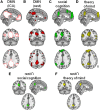On the relationship between the "default mode network" and the "social brain"
- PMID: 22737119
- PMCID: PMC3380415
- DOI: 10.3389/fnhum.2012.00189
On the relationship between the "default mode network" and the "social brain"
Abstract
The default mode network (DMN) of the brain consists of areas that are typically more active during rest than during active task performance. Recently however, this network has been shown to be activated by certain types of tasks. Social cognition, particularly higher-order tasks such as attributing mental states to others, has been suggested to activate a network of areas at least partly overlapping with the DMN. Here, we explore this claim, drawing on evidence from meta-analyses of functional MRI data and recent studies investigating the structural and functional connectivity of the social brain. In addition, we discuss recent evidence for the existence of a DMN in non-human primates. We conclude by discussing some of the implications of these observations.
Keywords: TPJ; default mode network; fMRI; medial frontal cortex; mentalizing; posterior cingulate; social cognition; theory of mind.
Figures



References
-
- Anderson J. S., Nielsen J. A., Froehlich A. L., DuBray M. B., Druzgal T. J., Cariello A. N., Cooperrider J. R., Zielinski B. A., Ravichandran C., Fletcher P. T., Alexander A. L., Bigler E. D., Lange N., Lainhart J. E. (2011). Functional connectivity magnetic resonance imaging classification of autism. Brain 134(Pt 12), 3742–3754 10.1093/brain/awr263 - DOI - PMC - PubMed
-
- Andreasen N. C., O'Leary D. S., Cizadlo T., Arndt S., Rezai K., Watkins G. L., Ponto L. L., Hichwa R. D. (1995). Remembering the past: two facets of episodic memory explored with positron emission tomography. Am. J. Psychiatry 152, 1576–1585 - PubMed
Grants and funding
LinkOut - more resources
Full Text Sources
Other Literature Sources

